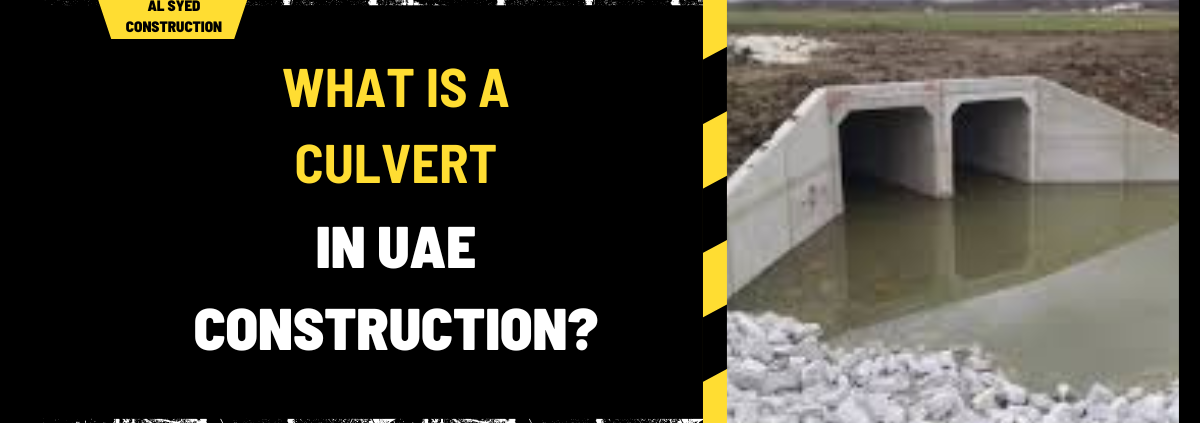What is a Culvert in UAE Construction? A Comprehensive Guide
Culverts are essential components in civil engineering and construction projects, facilitating the management of water flow and maintaining infrastructure stability. In this detailed guide, we explore the various aspects of culverts, including their types, functions, installation processes, and considerations for effective design and maintenance.
1. Definition and Purpose of a Culvert
What is a Culvert?
A culvert is a structure designed to channel water through or under a road, railway, or embankment. Typically made from materials such as concrete, metal, or plastic, culverts ensure that water flow is maintained, preventing erosion and damage to infrastructure. They are critical in managing stormwater and mitigating flood risks.
Primary Functions
- Water Flow Management: Culverts allow water to flow efficiently under roads and embankments, reducing the risk of flooding and erosion.
- Infrastructure Protection: By diverting water away from vulnerable areas, culverts help preserve the structural integrity of roads and bridges.
- Environmental Preservation: Properly designed culverts support the natural flow of streams and rivers, aiding in the maintenance of aquatic ecosystems.
2. Types of Culverts
1. Pipe Culverts
Pipe culverts are among the most common types. They are cylindrical and can be made from various materials, including:
- Concrete: Durable and widely used, concrete pipe culverts are effective for large water flows.
- Metal: Corrugated metal pipes are often used for smaller culverts and offer flexibility in installation.
- Plastic: Lightweight and corrosion-resistant, plastic pipes are suitable for less demanding applications.
2. Box Culverts
Box culverts are rectangular or square in shape and are typically constructed from reinforced concrete. They are used in situations where:
- High Water Flow: Larger cross-sectional areas are needed to handle significant water volumes.
- Urban Areas: Box culverts fit well in urban settings where space is limited and aesthetics are important.
3. Arch Culverts
Arch culverts feature a curved design that distributes the load across the structure. They are beneficial for:
- Aesthetic Appeal: Their design blends well with natural landscapes and is often used in scenic areas.
- Load-Bearing Capacity: The arch shape provides enhanced structural strength, making them suitable for heavy traffic areas.
4. Bridges and Aqueducts
For larger spans or special applications, bridges and aqueducts can serve as culverts. These structures are typically used when:
- Crossing Wide Channels: Large bodies of water require more extensive solutions than traditional culverts.
- Architectural Considerations: They provide a visually appealing solution for significant water crossings.
3. Design Considerations for Culverts
1. Hydrological Analysis
Before designing a culvert, a thorough hydrological analysis is essential. This involves:
- Assessing Water Flow: Estimating the volume and velocity of water that the culvert needs to accommodate.
- Determining Flood Risks: Evaluating potential flood scenarios to ensure the culvert can handle extreme conditions.
2. Material Selection
Choosing the right material for a culvert depends on:
- Water Quality: Different materials withstand varying levels of acidity and contaminants.
- Environmental Impact: Selecting materials that minimize ecological disruption and support sustainability.
3. Structural Design
The structural design of a culvert must account for:
- Load-Bearing Capacity: Ensuring the culvert can support the weight of traffic or other loads without failure.
- Durability: Designing for long-term use and resistance to environmental conditions such as corrosion and erosion.
4. Installation Considerations
Proper installation is crucial for the functionality and longevity of a culvert:
- Site Preparation: Clearing and grading the site to ensure a stable foundation.
- Alignment and Slope: Correctly aligning the culvert with the natural flow of water and ensuring an appropriate slope for efficient drainage.
- Backfilling and Compaction: Properly backfilling and compacting soil around the culvert to support its structure and prevent settlement.
4. Maintenance and Inspection
1. Routine Inspections
Regular inspections are vital to ensure the continued effectiveness of a culvert:
- Checking for Blockages: Ensuring that debris or sediment does not obstruct water flow.
- Inspecting for Damage: Identifying and repairing any cracks or structural issues.
2. Cleaning and Repairs
Maintaining a culvert involves:
- Cleaning: Removing accumulated debris, leaves, and sediment to prevent clogs.
- Repairs: Fixing any structural damage or corrosion promptly to avoid further deterioration.
3. Upgrades and Replacements
In cases where a culvert no longer meets the required standards, it may be necessary to:
- Upgrade: Enhance the existing culvert to handle increased water flow or load.
- Replace: Install a new culvert if the existing one is beyond repair or no longer suitable.
5. Environmental and Regulatory Considerations
**1. Environmental Impact
Culvert design and construction should consider the potential impact on local ecosystems:
- Fish Passage: Designing culverts to accommodate aquatic species and maintain natural migration routes.
- Water Quality: Ensuring that culverts do not contribute to pollution or disrupt natural water cycles.
**2. Regulatory Compliance
Adhering to local and national regulations is essential for:
- Permitting: Obtaining the necessary permits before construction begins.
- Standards: Following design and construction standards set by regulatory bodies to ensure safety and environmental protection.
Conclusion
Culverts play a crucial role in managing water flow, protecting infrastructure, and preserving the environment. By understanding the different types of culverts, their design considerations, and maintenance requirements, we can ensure that these structures function effectively and sustainably. Proper planning, design, and upkeep are essential to maximizing the benefits of culverts and mitigating potential issues.




